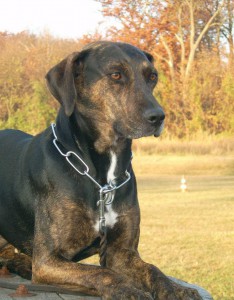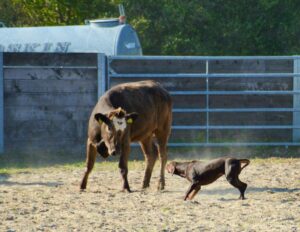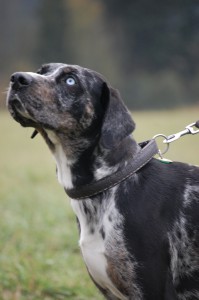 A typical merle coat color, i.e. coat with patches of diluted pigment irregularly spread over body and intermingled with undiluted melanin, is known in several breeds, such as Australian Sphepard, Collie, Border Collie, Cardigan Welsh Corgi, Shetland Sheepdog, Dachshund, etc. However, individuals with such a merle coat coloring are not a majority in those breeds. It is probably due to breeding regulations valid for those breeds that prevent combinations of both merle colored parents. The main reason for an existence of such breeding rules is a fact that offsprings of predominantly white color (called double merle) are born from such merle parents and they are known to suffer often from a variety of serious health defects.
A typical merle coat color, i.e. coat with patches of diluted pigment irregularly spread over body and intermingled with undiluted melanin, is known in several breeds, such as Australian Sphepard, Collie, Border Collie, Cardigan Welsh Corgi, Shetland Sheepdog, Dachshund, etc. However, individuals with such a merle coat coloring are not a majority in those breeds. It is probably due to breeding regulations valid for those breeds that prevent combinations of both merle colored parents. The main reason for an existence of such breeding rules is a fact that offsprings of predominantly white color (called double merle) are born from such merle parents and they are known to suffer often from a variety of serious health defects.
However, there is one breed that is famous for its merle colors and leopard patterns – Louisiana Catahoula (LC). It seems that for many breeders from country of its origin, USA, solid colored LC are not so popular. Thus, a combination of both merle carrying parents is done on purpose to obtain merle carrying offsprings of leopard colors in spite of possible 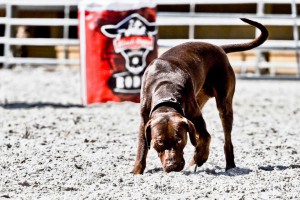 health defects. No surprice then that most dogs of this breed are the merle gene carriers and true solid colored (not carrying the merle gene) are rather rare. Nevertheless, it seems that the breed itself is not endangered by this fact seriously and the occurrence of the merle caused defects is not higher than in other merle carrying breeds.
health defects. No surprice then that most dogs of this breed are the merle gene carriers and true solid colored (not carrying the merle gene) are rather rare. Nevertheless, it seems that the breed itself is not endangered by this fact seriously and the occurrence of the merle caused defects is not higher than in other merle carrying breeds.
The Merle gene was identified by Clark et al. (PNAS 103 (5): 1376-81, 2006) in 2006. It opened the era of possible genetical testing of entire dog populations from this point of view. Clark et al. demonstrated that the gene in question is SILV (Silver locus, Pmel17). Its function is not fully understood, but it is known as one of pigment dilution genes and its  significant expression is localized exclusively to the skin and eye. They proved that genetical modifications (mutations) in SILV gene affect its normal function and it results in a coat pattern where a diluted pigment is mixed with patches of normal, undiluted melanin. Non-modified SILV gene is marked as m, while modified versions are marked as M, i.e. the merle gene. Modifications in SILV gene are caused by an insertion of a mobile gene element, called retrotransposon (SINE), which can be of various length, as we know now. It seems that the length of this SINE insertion affects the way how the merle gene manifests itself in dog phenotype.
significant expression is localized exclusively to the skin and eye. They proved that genetical modifications (mutations) in SILV gene affect its normal function and it results in a coat pattern where a diluted pigment is mixed with patches of normal, undiluted melanin. Non-modified SILV gene is marked as m, while modified versions are marked as M, i.e. the merle gene. Modifications in SILV gene are caused by an insertion of a mobile gene element, called retrotransposon (SINE), which can be of various length, as we know now. It seems that the length of this SINE insertion affects the way how the merle gene manifests itself in dog phenotype.
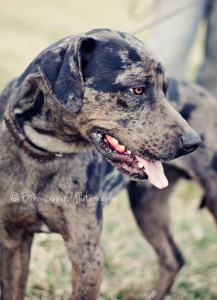 There were two modification of SILV gene described in the original article of Clark et al. The normal M gene includes the insertion of the length of 259-262 bp. It causes the typical merle/leopard coat pattern in dogs, heterozygous for it (mM), and the typical double merle phenotype with predominant white coloring in dogs homozygous (MM).
There were two modification of SILV gene described in the original article of Clark et al. The normal M gene includes the insertion of the length of 259-262 bp. It causes the typical merle/leopard coat pattern in dogs, heterozygous for it (mM), and the typical double merle phenotype with predominant white coloring in dogs homozygous (MM).
Another modification referred by Clark et al. contains a shorter insertion of the length of 220-225 bp. This modification of SILV gene is called cryptic (phantom) merle, Mc, and it seemes to have no apparent effect on coat coloring. Both heterozygous (mMc) and homozygous (McMc) individuals appear to be of solid
coat color, similarly as homozygous dogs with non-modified SILV gene, i.e. mm. As far as we know now, there is only one way to differentiate them from non-merle gene carriers – by genetical testing.
Both above mentioned modifications of SILV gene were recognized in all breeds, studied then. The merle gene seems to be inherited in an autosomal, incompletely dominant way. Offspring gets one allel of this gene from both parents and resulting genotypes are divided according to Mendel′s rules.
„Catahoula“ Merle Gene was identified by wide-spread testing for the merle gene presence in LC population. It is another modification of SILV gene, i.e. the insertion of medium length containing 243 -249 bp, which seems to be specific for LC breed. To distinguish it from above, I called it Ma as working name. The length of this insertion is medium to M and Mc and it affects phenotype less than M, but more than Mc. Dogs heterozygous for Ma (i.e. mMa) are born with solid colored phenotype, which seems to change more or less to the merle pattern during ageing.
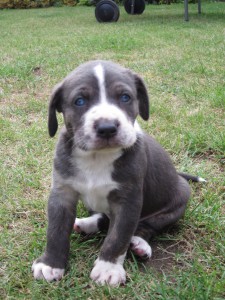 Dogs homozygous for this gene, i.e. MaMa, show the merle pattern since a birth, but it is usually all in diluted colors such as blue. There is no or only a little white color present usually, even if they are double merle, too.
Dogs homozygous for this gene, i.e. MaMa, show the merle pattern since a birth, but it is usually all in diluted colors such as blue. There is no or only a little white color present usually, even if they are double merle, too.
A combined genotype for M and Ma, i.e. MaM, seems to be a typical for patchwork phenotype, which is specific by larger areas of undiluted, leopard and white colors.
Heterozygous dogs for McMa are born as solid colored, showing most probably some merle pattern later as above mentioned (mMa).
The presence of LC specific modification of SILV gene, i.e. Ma, is probably a point missing until now. It explains well those examples, where the merle phenotypes were born out of „solid“ colored parents.
At this moment and our present knowledge, it seems that no additional modifiers of the merle gene are needed to explain differences that make the merle gene behave in LC different from other breeds. However, any regulation, modification or cooperation with other genes cannot be excluded fully until we have more information about the merle gene expression mechanisms and a presence, effects and cooperation with e.g. piebald gene, which is surely present in genome of some LC.
Determination of the Merle gene, which is used in Biofocus laboratories, originates from the methods of Clark et al., i.e. PCR analyses of gene products using specific primers. The analyse itself starts with an isolation of DNA from samples taken from dogs. Our practical experience proved that blood is more reliable starting material for DNA isolation.
Recent results also showed that LC is a „merle gene grown through“ breed. It was proved that 80 % of all tested LC were merle gene carriers. There were more than 30 % of double merles and more than 30 % of those carriers that looked as solid ones.
Written by: RNDr. Helena Synková
Explanation of basic terms:
A phenotype is an organism’s observable characteristics or traits: such as its morphology, development, biochemical or physiological properties, behavior. Phenotypes result from the expression of an organism’s genes as well as the influence of environmental factors and the interactions between the two.
The genotype of an organism is the inherited instructions it carries within its genetic code. Not all organisms with the same genotype look or act the same way because appearance and behavior are modified by environmental and developmental conditions. Similarly, not all organisms that look alike necessarily have the same genotype.

